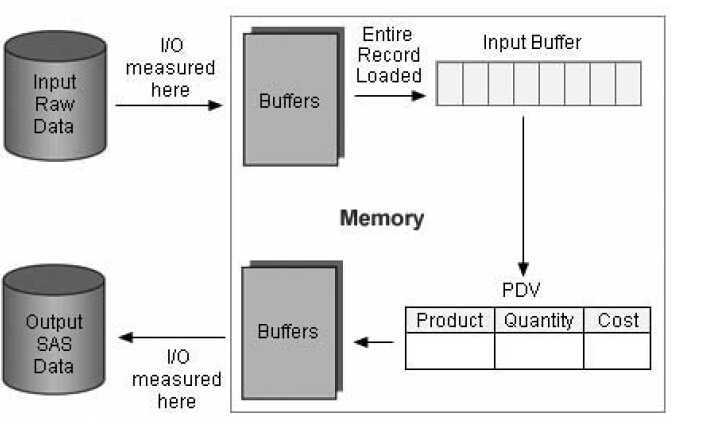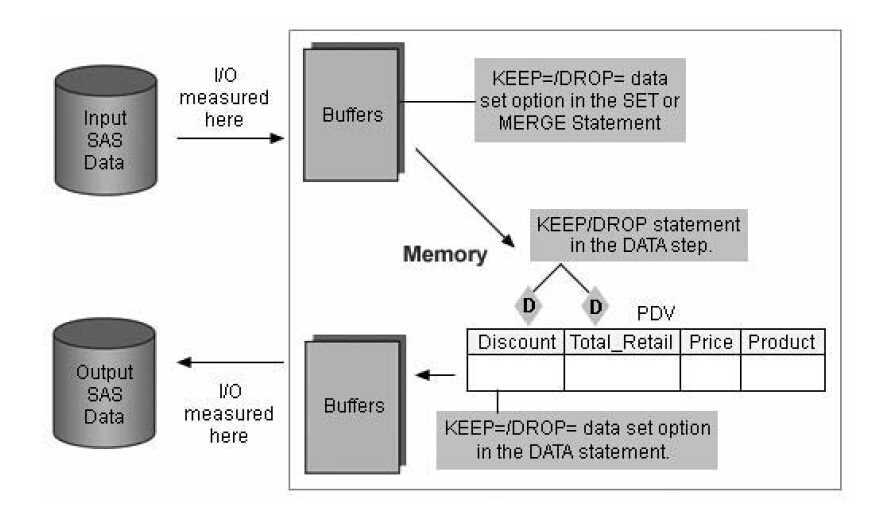标签:style blog http io ar color 使用 sp for
1:where和If最本质的区别,以及一些小的区别
1.1:The WHERE statement examines what is in the input page buffer and selects observations before they are loaded in the program data vector, which results in a savings in CPU operations(Where从buffer中进行筛选再读入pdv)
The subsetting IF statement loads all observations sequentially into the program data vector. If the statement finds a match and the statement is true, then the data is processed and is written to the output page buffer(If先读入pdv再进行筛选)
1.2:if可以从input的数据和sas数据集的数据中进行筛选,where只能筛选sas数据集的数据
if可以if语句的条件条件选择子句,where不能

where比if高效
where中能用contains的地方一律考虑用like
if语句<可执行语句>
IF statement tells SAS which observations to include, the DELETE statement tells SAS which observations to exclude
IF Sex = ‘f‘; IF Sex = ‘m‘ THEN DELETE; 作用一样!
data b;
set sashelp.class;
if _n_ le 4; *如果if为真,则继续执行if后面的语句,最后输出满足if的条件的观测,如果if为假则立刻返回到data步开头继续执行下一条set语句;
y = ‘now‘;
/*
y = ‘now‘;
if _n_ le 4;也能得出同样的结果,但是效率相对来说较低,因为要重复执行y的赋值语句
*/
run;
if的另外两种格式
if x=3 then y=4; 对于要表达的只有一条数据就用then
if x=3 then do y=4;z=5;end; 对于要表达的有多条语句就用then do end;
NOTE: 从数据集 SASHELP.CLASS. 读取了 19 个观测
NOTE: 数据集 WORK.B 有 4 个观测和 6 个变量。
NOTE: “DATA 语句”所用时间(总处理时间):
实际时间 0.03 秒
CPU 时间 0.03 秒 日志中读入了19个观测,证明是全部读入再一个个判断是否满足条件
data a;
input x y@@;
cards;
1 10 1 20 0 200 2 30 2 40
3 50 3 60 4 70 3 80 4 400
;
run;
proc sort data=a;by x;run;
data b;
set a;
*where x ; *后面不添加条件是筛选x不为0和不为缺失值的数值型数据,只适用于数值型;
where x is not missing; *筛选x不为缺失值的数据包括0,适用于数值型和字符型;
run;
proc print data=b noobs;
where和if的最重要的几点区别
1:where不可执行、if可执行
2:where有自己特定的表达式,if是是通用表达式 例如where x is missing;
3:where只能从现有的sas数据集中选择观测,if语句还可以用input语句产生的观测中选择。*商用的一般都是现有的sas数据集;
4:where的效率比if高
5:何时使用if何时使用where?如果需要对pdv观测进行处理才能决定哪条观测,只能使用if。其余能使用where
2:select 、if else if的选择
For numeric variables, SELECT statements should always be slightly more efficient (use less CPU time) than IF-THEN/ELSE statements. The performance gap between IF-THEN/ELSE and SELECT statements gradually widens as the number of conditions increases
For character variables, IF-THEN/ELSE statements are always more efficient than SELECT statements. The performance gap widens quickly between the two techniques as the number of conditions increases.
使用两种选择方式的最佳情况
Use IF-THEN/ELSE statements when
?? 1:the data values are character values
?? 2:the data values are not uniformly distributed
?? 3:there are few conditions to check.
Use SELECT statements when
?? 1:you have a long series of mutually exclusive numeric conditions
?? 2:data values are uniformly distributed.
3:where和obs/firstobs连用,来选择需要的观测行
记住,obs/firstobs是逻辑上选择观测值,并不是实际选择也就意味着不会去除其他的观测值
where在obs/firstobs前执行
4:读入外部数据时选择需要的obs
先看一张外部数据读入后sas程序内部的流程图

这里不能用where来截取子集,因为where不能用于筛选外部数据。
这里将if放在input后筛选读入pdv的观测行来减少cpu的运行时间
I/O的次数指的是外部data和buffers之间的通信的次数,减少的方式肯定是不能通过where/if等语句,只可能通过bufno、bufsize、sasfile等选项
5:keep/drop
下图展示keep和drop对于数据的作用环节

buffer后的keep、drop可以减少输入pdv中的变量个数从而减少CPU time
buffer前的keep、drop可以减少读入buffer中的变量个数也就是读入数据的总大小,从而减少I/O次数
sas优化技巧(4)执行必要的部分where,if、select,if else、obs firstobs、读入外部数据时选择需要的obs(if+input)、keep/drop
标签:style blog http io ar color 使用 sp for
原文地址:http://www.cnblogs.com/yican/p/4133030.html